《国际贸易实务》试题2
国际贸易实务试卷(二)答案
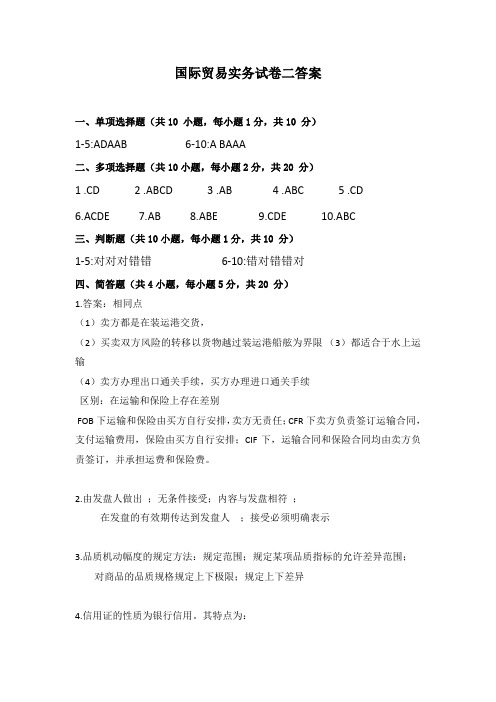
国际贸易实务试卷二答案一、单项选择题(共10 小题,每小题1分,共10 分)1-5:ADAAB 6-10:A BAAA二、多项选择题(共10小题,每小题2分,共20 分)1 .CD2 .ABCD3 .AB4 .ABC5 .CD6.ACDE7.AB8.ABE9.CDE 10.ABC三、判断题(共10小题,每小题1分,共10 分)1-5:对对对错错6-10:错对错错对四、简答题(共4小题,每小题5分,共20 分)1.答案:相同点(1)卖方都是在装运港交货,(2)买卖双方风险的转移以货物越过装运港船舷为界限(3)都适合于水上运输(4)卖方办理出口通关手续,买方办理进口通关手续区别:在运输和保险上存在差别FOB下运输和保险由买方自行安排,卖方无责任;CFR下卖方负责签订运输合同,支付运输费用,保险由买方自行安排;CIF下,运输合同和保险合同均由卖方负责签订,并承担运费和保险费。
2.由发盘人做出;无条件接受;内容与发盘相符;在发盘的有效期传达到发盘人;接受必须明确表示3.品质机动幅度的规定方法:规定范围;规定某项品质指标的允许差异范围;对商品的品质规格规定上下极限;规定上下差异4.信用证的性质为银行信用。
其特点为:(1)信用证是一种有条件的保证付款的凭证,但不同于一般的银行担保。
(2)信用证是依据买卖合同开立的,但它又是独立于合同之外的自足的文件。
(3)信用证只凭指定的单据付款,它是一种单据买卖。
五、案例分析题(共2小题,每小题10分,共20 分)1.依公约不构成不可抗力。
大豆是种类物,合同不要求特定产地。
外商可从其他地方购买。
还有4个月交货,外商有足够的时间从其他地方购买。
外商要履约,否则我方保留追索权。
2.中方公司做法不妥。
根据UCP600,允许分批装运,该信用证与合同不相冲突。
中方公司这样做虽没违反信用证,但违反了合同,外商有权索赔或拒收货物。
六、计算题(共2小题,每小题10分,共20 分)1.保险金额计算的公式是:保险金额=CIF货值×(1+加成率)。
国际贸易实务考试试题

国际贸易实务考试试题一、选择题(每题2分,共20分)1. 国际贸易中,最常见的贸易术语是()。
A. FOBB. CIFC. EXWD. DDP2. 在国际贸易中,信用证支付方式的主要优点是()。
A. 保障卖方收到货款B. 保障买方获得货物C. 减少运输成本D. 提高货物价格3. 以下哪项不属于国际货运保险的范围?()。
A. 偷窃B. 自然损耗C. 战争风险D. 自然灾害4. 关于国际贸易合同的法律适用,以下说法正确的是()。
A. 只能适用卖方所在国法律B. 只能适用买方所在国法律C. 可以适用第三国法律D. 必须适用联合国国际货物销售合同公约5. 国际贸易中的“样品交易”通常用于()。
A. 确认产品质量B. 确定货物数量C. 选择运输方式D. 决定包装材料6. 国际贸易中,买方要求延期付款的情况,卖方通常会要求()。
A. 降价处理B. 增加保证金C. 签订新的合同D. 取消交易7. 以下哪项是国际贸易中的风险转移点?()。
A. 生产完成B. 货物装船C. 货物到达目的地D. 买方收到货物8. 在国际贸易中,以下哪种货币被认为是硬通货?()。
A. 越南盾B. 土耳其里拉C. 美元D. 阿根廷比索9. 国际贸易合同中,关于货物的检验,通常由()负责。
A. 卖方B. 买方C. 第三方检验机构D. 运输公司10. 在国际贸易中,解决争议的最常见方式是()。
A. 仲裁B. 诉讼C. 调解D. 协商二、填空题(每题2分,共20分)11. 在国际贸易中,货物的所有权从卖方转移到买方的术语称为__________。
12. 国际贸易合同中,通常规定货物的交付地点为__________。
13. 信用证支付方式中,银行对卖方的付款保证是基于__________的符合。
14. 在国际贸易中,货物的装运通知通常包括__________、装运日期和预计到达时间等内容。
15. 国际贸易中,买方为了确保交易安全,通常会要求卖方提供__________。
国际贸易实务试题及答案
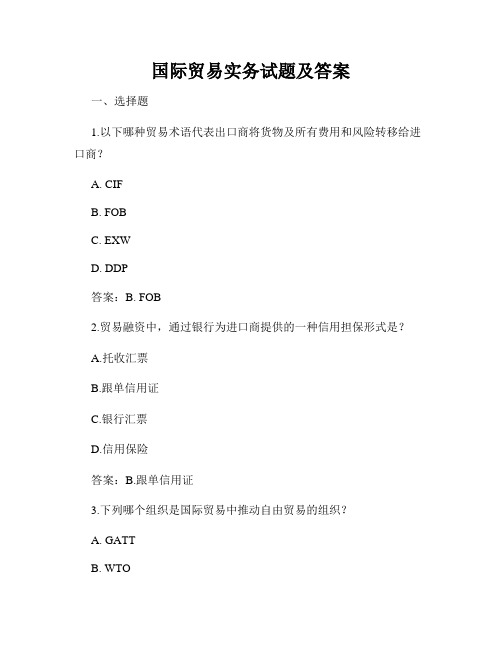
国际贸易实务试题及答案一、选择题1.以下哪种贸易术语代表出口商将货物及所有费用和风险转移给进口商?A. CIFB. FOBC. EXWD. DDP答案:B. FOB2.贸易融资中,通过银行为进口商提供的一种信用担保形式是?A.托收汇票B.跟单信用证C.银行汇票D.信用保险答案:B.跟单信用证3.下列哪个组织是国际贸易中推动自由贸易的组织?A. GATTB. WTOC. IMFD. UN答案:B. WTO4.以下哪个国际贸易术语代表进口商负责将货物从船上卸载并承担所有费用和风险?A. CIFB. FOBC. EXWD. DDP答案:A. CIF5.下列哪个国际支付方式最为安全可靠,同时需通过银行间接结算?A.电汇B.信用证C.承兑汇票D.票据汇款答案:B.信用证二、简答题1.请简要介绍自由贸易区(FTA)和关税同盟(CU)的区别。
答案:自由贸易区是指一组国家或地区之间达成的贸易协议,取消彼此之间的关税和非关税壁垒,但每个成员国可以保留自己的关税政策对其他非成员国实施。
关税同盟是在自由贸易区的基础上进一步发展,成员国在取消彼此之间的关税的同时,还要对非成员国实施统一的关税政策。
2.请简述什么是最惠国待遇(MFN)原则。
答案:最惠国待遇原则是指在国际贸易中,对待所有成员国应当平等,不得对一国享有的一种贸易条件或优惠待遇而不给予另一国。
即一国对任何一个成员国给予的最有利的条件或待遇,都必须同时给予其他的成员国。
3.请解释什么是转口贸易。
答案:转口贸易是指进口商将其进口的商品再出口到其他国家或地区,而不经过进口国市场的贸易行为。
进口商在转口贸易中起到中间商的作用,通过转口贸易能够实现利润的最大化。
三、论述题请以500字左右的篇幅,阐述区域经济一体化对国际贸易的影响。
答:区域经济一体化对国际贸易具有深远的影响。
首先,区域经济一体化通过取消关税和非关税壁垒,促进了成员国之间的贸易自由化。
成员国之间的关税减少甚至取消,进口和出口商品的价格更为便宜,促进了贸易的增长。
国际贸易实务试题
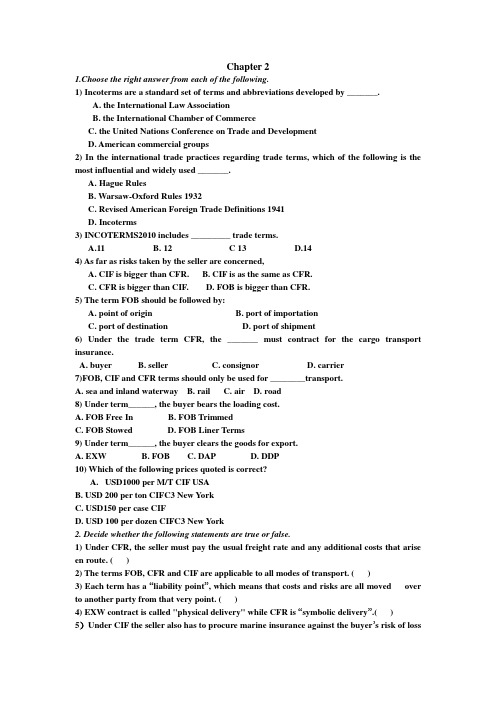
Chapter 21.Choose the right answer from each of the following.1) Incoterms are a standard set of terms and abbreviations developed by _______.A. the International Law AssociationB. the International Chamber of CommerceC. the United Nations Conference on Trade and DevelopmentD. American commercial groups2) In the international trade practices regarding trade terms, which of the following is the most influential and widely used _______.A. Hague RulesB. Warsaw-Oxford Rules 1932C. Revised American Foreign Trade Definitions 1941D. Incoterms3) INCOTERMS2010 includes _________ trade terms.A.11B. 12 C 13 D.144) As far as risks taken by the seller are concerned,A. CIF is bigger than CFR.B. CIF is as the same as CFR.C. CFR is bigger than CIF.D. FOB is bigger than CFR.5) The term FOB should be followed by:A. point of originB. port of importationC. port of destinationD. port of shipment6) Under the trade term CFR, the _______ must contract for the cargo transport insurance.A. buyerB. sellerC. consignorD. carrier7)FOB, CIF and CFR terms should only be used for ________transport.A. sea and inland waterwayB. railC. airD. road8) Under term______, the buyer bears the loading cost.A. FOB Free InB. FOB TrimmedC. FOB StowedD. FOB Liner Terms9) Under term______, the buyer clears the goods for export.A. EXWB. FOBC. DAPD. DDP10) Which of the following prices quoted is correct?D1000 per M/T CIF USAB. USD 200 per ton CIFC3 New YorkC. USD150 per case CIFD. USD 100 per dozen CIFC3 New York2. Decide whether the following statements are true or false.1) Under CFR, the seller must pay the usual freight rate and any additional costs that arise en route. ( )2) The terms FOB, CFR and CIF are applicable to all modes of transport. ( )3) Each term has a “liability point”, which means that costs and risks are all moved over to another party from that very point. ( )4) EXW contract is called "physical delivery" while CFR is “symbolic delivery”.( )5)Under CIF the seller also has to procure marine insurance against the buyer’s risk of lossof or damage to the goods during the carriage. ( )Chapter 31. Review and Discussion Questions1)How is packing of goods classified in international trade? What are some of themajor functions of each type of packing?2)Please describe the standardized form of shipping mark suggested by ISO?3)What is neutral packing? Why is it used in international trade?2. Choose the right answer from each of the following.1)________ , usually made of jute, are suitable for transporting such cargoes as cement, fertilizer, flour, animal feeding products, chemicals, etc.A. BalesB. SacksC. CartonsD. Cases2)________ are a kind of portable platforms intended for handling, storing, or movingmaterials and packages;A. Flexible containersB. Large metal containersC. Corrugated boxesD. Pallets3) ______ acts as “a silent salesman”.A. Shipping packingB. Shipping markC. Sales packingD. Neutral packing4) Neutral packing is chiefly used for _______different limitations and politicaldiscriminations of importing countries and regions.A. openingB. setting upC. setting asideD. breaking through5) _______ is composed of a specific geometric figure, abbreviations of consignee, the port ofdestination and the package number.A. Shipping markB. Indicative markC. Warning markD. No mark6) _______ , also called dangerous cargo marks, are used to remind the cargohandlers to take necessary safety measures.A. Indicative marksB. Warning marksC. Shipping marksD. Sales packing7) ________ are mainly used for transport packing of hazardous goods.A. Warning marksB. Shipping marksC. Indicative marksD. Subsidiary marks8) _______ should clearly stipulate the packing material, manner of packing, packing specification, packing expenses to be borne, shipping marks and so on.A. Quality clauseB. Quantity clauseC. Shipment clauseD. Packing clause9) According to international trade practice, shipping marks are usually designated by _________ and it is not necessary to specify them in the contract.A. the importerB. the exporterC. the carrierD. the forwarder3. Decide whether the following statements are true or false1) The primary function of sales packaging is to protect the product . ( )2) Transport packing is not only adopted as a form of protection to reduce the risks of goods being damaged in transit and prevent pilferage, but also used for the propose of promoting sales. ( )3) UPC and EAN are the two main bar codes used internationally. ( )4) Neutral packing is a kind of packing which only shows the origin of country and doesn’t show the name and address of the manufacturer. ( )5) Shipping marks are not only stenciled on the transport packing of cargoes but also appear on the commercial documents such as invoices, insurance policy or certificate, bills of lading, etc. ( )6) ISO has suggested a standardized form of shipping mark, which is composed of a specific geometric figure, abbreviations or initials of a consignee, the port of destination and the package number. ( )7) Requirements for shipping marks for road, railway and air transport are the same as those for ocean transport. ( )8) Generally speaking, the packing expenses are included in the price, and shall be borne by the exporter. ( )9) In international sales of goods, “seaworthy packing”, “customary packing” and “seller’s usual packi ng” are commonly used in the packing clause. They are favorable for the seller. ( )Chapter 41. Review and Discussion Questions1) What are the major types of transportation in international cargo transport?2) What are the characteristics of liner transport?3) What are the differences between voyage charter and time charter?4) What are the main functions of B/L?5) What main points are included in the clause of shipment2. Choose the right answer from each of the following.1) If items marked with “AD Val.”, the freight is to be calculated on the basis of _______ of the cargo concerned.A. weightB. price or valueC. measurementD. volume2) Freight under liner transportation _______.A. needs to stipulate demurrage and dispatch money between the shipper and the carrierB. does not include loading and unloading costC. consists of basic charges and additional chargesD. is collected based on gross weight of the goods3) Airway bill is NOT________.A. a transport contract between the consignor and the carrierB. a document for customs clearanceC. a document for bank negotiationD. a document of title4) ________is the most commonly used transportation mode, which occupies 2/3 of international transportationA. Railway transportationB. Maritime transportationC. Air transportationD. Parcel transportation5) In international trade, the importer often does not require_______.A. shipped B/LB. clean B/LC. blank B/LD. order B/L6) _______ can be transferred after endorsement.A. straight B/LB. blank B/LC. order B/LD. through B/L7) Multi-modal transport operator is responsible for _________.A. the first voyageB. the whole voyageC. the ocean transport C. the last voyage8) Under ______ character, the ship-owner only rents the charterer the boat.A. demiseB. timeC. voyageD. booking9) _____is suitable for conveying fresh, emergent and seasonal goods.A. scheduled airlinesB. chartered carrierC. consolidated consignmentD. liners10) ______ can be freely bought and sold just like commodities.A. Railway billB. Airway billC. Shipping adviceD. Ocean bill of lading11)Under time charter,the charterer is not liable for costs such as_______.A.fuel expenses B.crew wages C.port charges D.loading and unloading expenses12) When applying to CIF,the expression of ocean bill of lading freight is ____.A. freight prepaidB. freight collectC. freight paidD. freight unpaid13)The person to whom the goods are shipped is called _______.A.the consignorB.the consigneeC.the shipperD.the manufacturer14)When one of the original bills of lading was surrendered to the carrier, the others become_______.A.valid B.validity C.invalid D.invalidity15)_______ are those covering shipment between direct ports of loading and discharge. A.Sipped bills of lading B.Clean bills of ladingC.Straight bills of lading D.Direct bills of lading16)When the goods arrive at the port of destination, _____ issue an Arrival Notice to inform the Notify Party about the cargo discharge point and other information.A. shipperB. carrierC. receiverD. ship owner17)In the following expressions,________ are not the proper ways of stipulating time of shipment.A. Shipment on or about June 20,2005B. Shipment not later than July 31st ,2005C. Shipment on June 20,2005D. Shipment to be made immediately18)As a consolidator, the forwarder will provide the service in his own name and issuea _______. .A.master bill of ladingB.house bill of ladingC.straight bill of ladingD.sea waybill19)Which of the following costs are payable by the charterer under a time charter party. _______. A. bunker costs and demurrageB.hull insurance and port chargesC.port charges and bunker costsD.wages of crew and hull insurance20)Which of the following charter party forms is used in a voyage charter. _______ A.GENCON B.BALTIME C.NYPE D.BARECON21)Piggyback is a system of unitized multimodal land transport by _______.A.road and sea B.road and rail C.road and air D.road and road22)Laytime and demurrage clause normally appeared in the _______Charter Party.A. TimeB. VoyageC. BareboatD. TCT23)Which of the following terms on the B/L shows that the Bill of Lading is clean B/L? _______A. insufficient packingB. one carton shortC. in apparent good order and conditionD. missing safety seal24) Which of the following modes of container transport may not be FCL/FCL_______A.CY/CYB.DOOR/DOORC.DOOR/CYD.CFS/CFS25) The terms under which the shipowner is not responsible for loading and discharging stowage and trimming costs is_______A. FOBSTB. FIOSTC. FIOSD. FIO26)The_______is the most important document for air cargo transportation.A.B/LB.AWBC.SWBD.L/C3. Decide whether the following statements are true or false1) The loading and unloading charges are included in the freight of the liners. ( )2) In order to clarify who will bear the loading and unloading charges in voyage charter transportation, the clause “Free in and out”is set forth in the Voyage Charter Party. This means the charterer shall be responsible for both loading and unloading charges.( )3) Dispatch money is a fine imposed on the charterer for the delay in the loading andunloading of the goods. ( )4) Straight B/L can be transferred through endorsement. ( )5) A bill of lading is both a receipt for merchandise and an evidence of contract for carriage. ( )6) Advantages of containerization include less handling of cargo, more protection against pilferage, reduced cost of transportation.( )7) Order B/L can be transferred with or without endorsement. ( )8) In international multi-modal transportation, a multi-modal transport operator will issue a combined transport document and be responsible for the safe carriage of the whole voyage. ( )9)The port charges are payable by shipowner during the period of voyage charter. ()10)LCL/LCL denotes the container service where the shipper is responsible for stuffing and the carrier is responsible for stripping. ()11)When traders set the time for shipment in a contract,the exporter should consider whether he can get the goods ready before the shipment date and whether the ship is available if the goods are ready. ()12) The date marked on the B/L is the date on which the carrier takes delivery of the goods. ()13)Tramp service is a carrier who operates a regular scheduled service. The vessels are usually chartered at negotiated rates,particularly when the quantity of cargo is large.()14)The Voyage chartering party includes the payment of dispatch and demurrage. ()15)Normally tramp rates fluctuate with market conditions of supply and demand.( )16)Under the voyage chartering, the shipowner is responsible for the fixed running expenses as well as for the voyage expenses.( )17)Specific Commodity Rates are normally lower than General Cargo Rates in air cargo transportation.( )18)Time of Shipment refers to the time limit for loading the goods at the port of shipment.19)Time chartering means that the charterer hires the vessel for a period of time without crew. ()20)The V oyage Charter means that the vessel is put at the disposal of the Charterer for a certain period employment without any crew. )21)Straight Bill of Lading are not negotiable and cannot be transferred to third parties.( )22)One of the advantages in multimodal transport is to minimize time loss at transshipment point.( )23)Usually, an Air Way bill is non-negotiable, that is, the goods must be sent to the consignee titled in the Air Waybill.( )Chapter 51.Choose the right answer from each of the following.1)This bid is ______ your reply reaching us within 15 working days from today.A up toB subject toC subjecting toD subjected to2)Our offer can only be left______ for five days, so you’d better e-mail us your acceptance.A acceptanceB correctC definiteD open3)Please reply to our inquiry ______ your earliest convenience.A byB uponC forD at4)Please note that our offer remains valid ______ July 15 for your acceptance.A. forB. onC. inD. until5) We find your quotation ______ men's shirts much too high.A. onB. forC. atD. to6)Bob is _______ the market for your new product, why don’t you call him right now?A atB inC seekingD entering7)a definite offer will be _______ on the offerer if the offer is accepted by the offeree.A. boundB. bindedC. boundedD. binding2. Decide whether the following statements are true or false1)It is a widely accepted rule in international trade that silence and inactivity on the part of offeree constitute acceptance( )2)If an offer does not indicate the offerer’s clear reservation about the validity, then the offer shall be regarded as a definite offer3)According to the Convention, an offer becomes valid as soon as it is dispatch.4)According to Convention, an offer should not be regarded as a definite offer unless it expressly indicates all the details relating to the transaction, including the validity for acceptance and the phrase to indicate finality.5)According to Convention, under no circumstances can an offer be revoked once it is made by the offerer.( )6)When accepting an offer, there should be no any material modification, addition or restriction in the acceptance. Otherwise such an offer would be regarded as a rejection of the offer and constitutes a counteroffer.()Chapter 61. Review and Discussion Questions1) What payment instruments are used in international trade?2) What is the difference between a bill of exchange and a promissory note?3) Describe the types of remittance and their advantages and disadvantages.4) What is the difference between clean collection and documentary collection?5) Describe the types of documentary collection.6) What is L/C? Which type of L/C is commonly used?7) What is the relationship between the L/C and the sales contract?2.Choose the right answer from each of the following.1) A draft is like a check that can be endorsed but it isn't a title to goods, like ______.A. a bill of ladingB. an inspection certificateC. a certificate of originD. an insurance certificate2) Documentary credit seeks ______ from the bank.A. guaranteeB. no guaranteeC. no protectionD. insurance3) The most common and safest payment method for international sales transactions is__________.A. Cash in AdvanceB. RemittanceC. CollectionD. L/C4) A bank informs the beneficiary that another bank has opened a letter of credit in his favor.The bank informing the beneficiary does not add its engagement. This bank is acting as________.A. an advising bankB. a confirming bankC. an issuing bankD. a negotiation bank5) A collecting bank is employed by ______.A.the principalB.the remitting bankC.the drawerD.the drawee6) The documentary collection provides the seller with a greater degree of protection than shipping on ______A.Open accountB.Banker’s letter of guaranteeC.Banker’s draftD.Documentary credit7) In what circumstances would the beneficiary of a confirmed documentary credit not receive payment? ______.A.Failure of the applicantB.Failure of the issuing bankC.Failure to fulfill the credit termsD.Failure to fulfill the commercial contract8)In a documentary credit transaction, payment is made in exchange for:A. goodsB. shipping documentsC. commercial invoiceD. bill of exchange9)These are four main methods of securing payment in international trade:(1) payment under documentary credit(2) open account(3) collection, that is document against payment or acceptance of a bill of exchange(4) payment in advanceFrom an exporter's point of view, the order of preference is ______.A. (4) , (2) , (3) , (1)B. (4) , (1) , (3) , (2)C. (4) , (3) , (1) , (2)D. (2) , (4) , (1) , (3)11) In terms of the risk for the exporter to get payment, the risk of the paymentmethods from the highest to the least is:A. L/C, D/P, D/A, and OAB. OA, D/A, D/P and L/CC. L/C, D/A, D/P and OAD. L/C, OA, D/A and D/P12) Under _________, the importer borrows the shipping documents from the collectingbank and takes the goods. When the draft matures, he effects payment.A. D/P at sightB. D/P after sightC. D/AD. D/D13) According to UCP600, which of the following documents must be issued /drawn bythe beneficiary unless otherwise stipulated by the Credit?A. draftB. B/LC. inspection certificateD. insurance policy14) If a buyer has goods delivered to him in installments at specified intervals, ________is often used so as to simplify formalities and reduce expensesA. a back-to-back L/CB. a revolving L/CC. a standby L/CD. a deferred payment L/C3.Decide whether the following statements are true or false1) In export business, the exporter generally chooses soft currency and in import, hetries to use hard currency. ( )2) Most of the promissory notes in use today are issued by individuals rather than bybanks. ( )3) A draft involves three parties: the drawer, the drawee and the payee. ( )4) The letter of credit is usually forwarded to the exporter by the importer. ( )5) Of the three types of remittance, T/T is most commonly used because of the fast speed.( )6) Remittance belongs to commercial credit while collection and letter of credit belong tobanker’s credit. ( )7) A clean L/C is favoured by the importers in international trade, because if it is used,the importers run no risks. ( )8)The exporter will run more risks to adopt D/A at 30 days sight than D/P at 30 days aftersight. ( )9) A standby L/C is different from a documentary L/C because under the documentary L/C,the issuing bank holds itself responsible for the payment of the goods, but under a standby L/C, the issuing bank holds itself responsible only after the applicant has not fulfilled its obligations. ( )10) In the context of international trade, the drawer and payer is usually the seller and thedrawee and payee is usually the buyer.( )11) A check is always paid upon presentation. ( )Chapter 71. Review and Discussion Questions.1) What are the fundamental principles of insurance?2) What are the major types of risks in marine cargo transport?3) What’s the difference between General Average and Particular Average?4) What are the major types of basic risks coverage and additional risks coverage?5) Explain the scope of coverage of F.P.A. and W.P.A.?6) What is W/W Clause?7) What is the difference between the insurance policy and insurance certificate?8) How to choose the right insurance coverage?2. Choose the right answer from each of the following.1) ________is defined as loss arising in the consequence of extraordinary and intentionalsacrifice made, or expenses incurred, for the common safety of the ship and cargo.A.Particular average B.General averageC.Without average D.With average2)Which of the following risks is not covered by the All Risks coverage of marine cargo transport insurance_______.A. delayB. floodC. lightningD. heavy weather3)WPA is one of the ______.A. basic risksB. additional risksC. special additional risksD. general additional risks4)Which of the following risks is not covered by the AR coverage of marine cargo transport insurance?A. marine perilsB. strandingC. pilferageD. inherent vice5) The insurer is not responsible for partial loss of or damage to cargo caused by natural calamities under the( )A.W AB.FPAC. All RisksD.Institute Cargo Clauses (A)6) In insurance, the party who insures others against possible loss or damage and promises to effect payment in case of loss or damage is called the _______A. insuredB. consigneeC. insurerD. consignor7) The All Risks of marine cargo transport insurance covers risks of__________.A. war and strikeB. general averageC. inherent vice of goodsD. stranding of ship8) Under the trade term CFR, the _______ must contract for the cargo transport insurance.A. buyerB. sellerC. consignorD. carrier9) General perils refer to natural ________and fortuitous accidents.A. calamitiesB. damagesC. lossesD. franchises10) Which of the following insurance coverage does not cover total loss of to cargo caused by earthquake or lightning? ( )A. W AB.FPAC. Institute Cargo Clause(B)D. Institute Cargo Clause(C)11)Which of the following risks are covered by the All Risks coverage of PICC Ocean Marine Cargo Clauses?A. war and fireB. strike and delayC. aflatoxin and on deckD. heavy weather and fire3.Decide whether the following statements are true or false1) An insurance contract is essentially a contract between the insurer and the insured. ( )2) The amount of money the insurer agrees to cover by insurance against the subject matter is the insured amount, which is normally 110% of CIF value of the consignment. ( )3) Under CIF term, the seller has to procure insurance against the buyer’s risk of loss of or damage to the goods during the carriage. ( )4) FPA coverage does not include total losses resulting from specific accidents, like an earthquake. ( )5) Special additional coverage such as war risks, strikes and so on must be taken out together with F.P.A. .W.A. or A.R. ( )6) General average and salvage charges are covered both in FPA and WA coverage. ( )7) A.R. does not cover risks of war and special additional risks but cover the general additional risks. ( )8) Three types of risks are covered by ocean marine insurance, namely the perils of the sea, the extraneous risks and the force majeure. ( )9) If you have insured your goods against A.R., you will get compensated whatever risks occurs to your goods. ( )10) A.R. covers all losses and damages to the goods caused by perils of the sea and extraneous risks.11)Ocean marine insurance covers two types of losses, partial loss and total loss. ( )12)Partial loss or damage is never recoverable with W A. ( )13)In ocean marine insurance, general average is to be borne by the carrier, who may, upon presentation of evidence of the loss, recover the loss from the underwriter. ( )14)In ocean marine insurance, the assured can recover more than actual loss provided that he can provide evidence of further losses contingent on the actual loss. ( )Chapter 81. Review and Discussion Questions1) Why must there be the inspection clause in international trade contracts? What does the inspection clause generally include?2) Please explain the three major ways of stipulating the place and time of inspection.3) How disputes are settled in international trade?4) What are some of the major characteristics of a force majeure event?5) Please give examples of three ways to set the scope of force majeure.6) Why is arbitration a commonly used settlement of disputes in international trade?2.Choose the right answer from each of the following.1. The necessary precondition of settling disputes by arbitration is that_______.A. there must be a sales contract between the disputing partiesB. there must be an arbitration agreement between the disputing partiesC. there must be mediation taking place firstD. there must be litigation taking place first2) Which of the following statements is not true about a force majeure event?A. A force majeure event may occur before the conclusion of the contractB. A force majeure event may lead to cancellation of the contract or delayed performance of the contractC. A force majeure event can be caused by natural forcesD. A force majeure event can be caused by social forces3) The most widely used way of stipulating the place and time of inspection in the contract is _______.A. shipping quality and weightB. landed quality and weightC. inspection at the port of shipment and re-inspection at the port of destinationD. shipping quantity and landed quality4) The award of arbitration is usually ______.A. finalB. not binding on all partiesC. amendableD. rejective5) Which of the following events is usually stipulated in the contract as force majeure?A. warB. rise of priceC. manufacturer’s refusal to supply to the sellerD. late delivery6) Generally, there is/are _____ way(s) to stipulate “force majeure” clauses.A. 1B. 2C. 3D. 47) Which of the following is governmental inspection body? _______A. Underwriter’s LaboratoryB. Lloyd’s SurveyorC. Food and Drugs AdministrationD. Societe General De Surveillance8) Which of the following is not true about the features of arbitration? _____A. The litigants should submit themselves voluntarily to an arbitrator.B. An arbitration agreement in written form between the parties concerned is prerequisite for arbitration.C. The aware is final and binding on both parties.D. Once the arbitration body is chosen, there is no need to stipulate the rule of arbitration procedure in the arbitration agreement because the rule of the arbitration body is applicable3. Decide whether the following statements are true or false1) For one contract, only one method and one standard should be used to ensure consistency in inspection. ( )2) Arbitration can be used to settle criminal cases as well as civil cases. ( )3) Usually an arbitration tribunal can consist of one, two or three arbitrators. ( )4) An arbitration award must be in written form with or without explanations or reasons. ( ) 7) When the departure term (EXW) is used, the commodity should be inspected at the factory or warehouse where the delivery is made. ( )8) If shipping quality is used in inspection, the inspection must be conducted at the seller’s factory only. ( )9) The party who suffers a force majeure event can decide to terminate the contract without notice to the other party. ( )。
中职电子商务专业课程《国际贸易实务》期末考试试卷二及答案
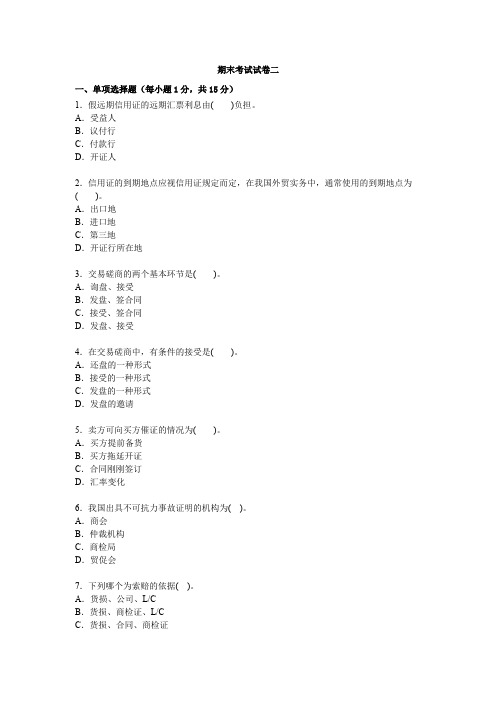
期末考试试卷二一、单项选择题(每小题1分,共15分)1.假远期信用证的远期汇票利息由( )负担。
A.受益人B.议付行C.付款行D.开证人2.信用证的到期地点应视信用证规定而定,在我国外贸实务中,通常使用的到期地点为( )。
A.出口地B.进口地C.第三地D.开证行所在地3.交易磋商的两个基本环节是( )。
A.询盘、接受B.发盘、签合同C.接受、签合同D.发盘、接受4.在交易磋商中,有条件的接受是( )。
A.还盘的一种形式B.接受的一种形式C.发盘的一种形式D.发盘的邀请5.卖方可向买方催证的情况为( )。
A.买方提前备货B.买方拖延开证C.合同刚刚签订D.汇率变化6.我国出具不可抗力事故证明的机构为( )。
A.商会B.仲裁机构C.商检局D.贸促会7.下列哪个为索赔的依据( )。
A.货损、公司、L/CB.货损、商检证、L/CC.货损、合同、商检证D.商检证、保险单、发票8.在CIF出口贸易中,由于码头工人野蛮装运导致货物包装破损,收货后买方应找索赔方为( )。
A.卖方B.船长C.港务D.保险公司9.根据现行伦敦保险协会《海运货物保险条款》的规定,采用“一切风险减除外责任”的办法表示的险别是()。
A.ICC(A)B.ICC(B)C.ICC(C)D.ICC(D)10.使用托收方式时,托收行和代收行在贷款收进方面( )。
A.没有责任B.承担部分责任C.有责任D.视情况分析11.在以规格与样品同时使用的出口贸易中,国外买方验货的质量依据一般为( )。
A.规格B.样品C.规格和样品D.规格或样品12.英美法系中达到与大陆法系处理违约金过高的同样效果的方法是( )。
A.预约赔偿金B.罚金C.两者均是D.两者均不是13.不可转让的汇票,其收款人应为( )。
A.指示性抬头B.限制性抬头C.持票人抬头D.某人抬头14.对卖方延迟交货常用的救济方法有( )。
A.实际履行和解除合同B.实际履行和损害赔偿C.解除合同和损害赔偿D.购买替代货物和损害赔偿15.报关时提交的单据主要有( )。
国际贸易实务考试题及答案自考

国际贸易实务考试题及答案自考一、单项选择题1. 国际贸易中,最常见的价格术语是()。
A. FOBB. CIFC. DDPD. EXW答案:A2. 在国际贸易中,L/C支付方式指的是()。
A. 信用证B. 汇票C. 托收D. 现金答案:A3. 根据《国际贸易术语解释通则》,CIF价格术语中卖方必须负责货物运输到()。
A. 装运港B. 目的港C. 转运港D. 任何港口答案:B4. 国际贸易中,买方开立的信用证到期后未付款,这种情况被称为()。
A. 违约B. 逾期C. 跳票D. 信用证过期答案:B5. 国际贸易合同中,不可抗力条款通常用来免除由于()导致的责任。
A. 战争B. 自然灾害C. 罢工D. 所有上述情况答案:D二、多项选择题6. 以下哪些因素可能影响国际贸易合同的履行?()A. 汇率波动B. 政治变动C. 运输成本D. 技术进步答案:A, B, C7. 国际贸易中,常见的支付方式包括()。
A. 预付款B. 信用证C. 托收D. 现金交易答案:A, B, C8. 根据国际贸易惯例,以下哪些行为属于卖方的责任?()A. 按时交付货物B. 承担所有运输费用C. 提供商业发票D. 办理出口清关手续答案:A, C, D9. 在国际贸易中,以下哪些情况可能导致合同违约?()A. 买方拒绝接受货物B. 卖方延迟交货C. 货物不符合合同规定D. 买方延迟付款答案:A, B, C, D10. 国际贸易中,以下哪些保险类型是常见的?()A. 海运保险B. 航空运输保险C. 陆运保险D. 所有上述保险答案:A, B, C, D三、简答题11. 简述FOB价格术语的含义及其对买卖双方的责任分配。
答案:FOB(Free On Board,船上交货)价格术语指的是卖方将货物装上船后,所有风险和费用就转移给买方。
在FOB术语下,卖方负责将货物装上船,并办理出口清关手续,而买方则负责从装运港到目的港的运输费用和保险费用,并承担货物装上船后的风险。
国际贸易实务试题及答案(二)
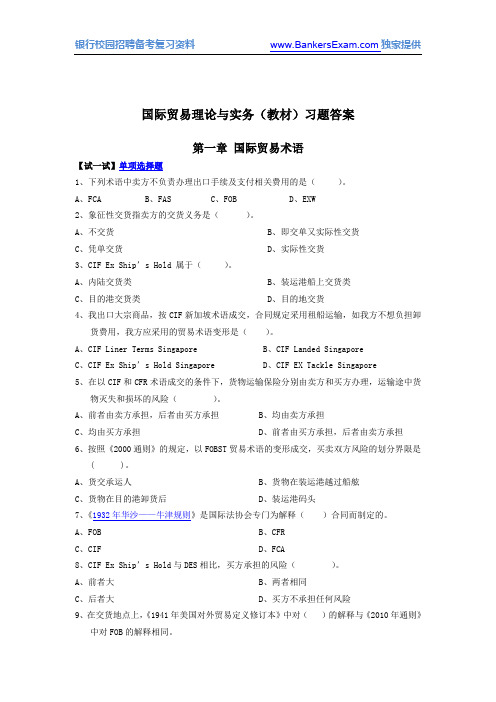
国际贸易理论与实务(教材)习题答案第一章国际贸易术语【试一试】单项选择题1、下列术语中卖方不负责办理出口手续及支付相关费用的是()。
A、FCAB、FASC、FOBD、EXW2、象征性交货指卖方的交货义务是()。
A、不交货B、即交单又实际性交货C、凭单交货D、实际性交货3、CIF Ex Ship’s Hold 属于()。
A、内陆交货类B、装运港船上交货类C、目的港交货类D、目的地交货4、我出口大宗商品,按CIF新加坡术语成交,合同规定采用租船运输,如我方不想负担卸货费用,我方应采用的贸易术语变形是()。
A、CIF Liner Terms SingaporeB、CIF Landed SingaporeC、CIF Ex Ship’s Hold SingaporeD、CIF EX Tackle Singapore5、在以CIF和CFR术语成交的条件下,货物运输保险分别由卖方和买方办理,运输途中货物灭失和损坏的风险()。
A、前者由卖方承担,后者由买方承担B、均由卖方承担C、均由买方承担D、前者由买方承担,后者由卖方承担6、按照《2000通则》的规定,以FOBST贸易术语的变形成交,买卖双方风险的划分界限是( )。
A、货交承运人B、货物在装运港越过船舷C、货物在目的港卸货后D、装运港码头7、《1932年华沙——牛津规则》是国际法协会专门为解释()合同而制定的。
A、FOBB、CFRC、CIFD、FCA8、CIF Ex Ship’s Hold与DES相比,买方承担的风险()。
A、前者大B、两者相同C、后者大D、买方不承担任何风险9、在交货地点上,《1941年美国对外贸易定义修订本》中对()的解释与《2010年通则》中对FOB的解释相同。
A、FOB Under TackleB、FOBC、FOB VesselD、FOB Liner Terms10、根据《2010年通则》的解释,CFR术语仅适用于水上运输,如果卖方先将货物交到货站或使用滚装与集装箱运输时,应采用()为宜。
《国际贸易实务》试卷及答案
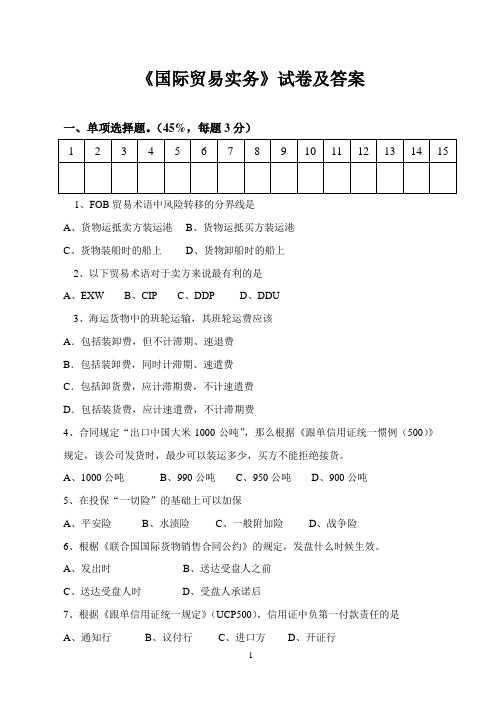
《国际贸易实务》试卷及答案一、单项选择题。
(45%,每题3分)1、FOB贸易术语中风险转移的分界线是A、货物运抵卖方装运港B、货物运抵买方装运港C、货物装船时的船上D、货物卸船时的船上2、以下贸易术语对于卖方来说最有利的是A、EXWB、CIPC、DDPD、DDU3、海运货物中的班轮运输,其班轮运费应该A.包括装卸费,但不计滞期、速退费B.包括装卸费,同时计滞期、速遣费C.包括卸货费,应计滞期费,不计速遣费D.包括装货费,应计速遣费,不计滞期费4、合同规定“出口中国大米1000公吨”,那么根据《跟单信用证统一惯例(500)》规定,该公司发货时,最少可以装运多少,买方不能拒绝接货。
A、1000公吨B、990公吨C、950公吨D、900公吨5、在投保“一切险”的基础上可以加保A、平安险B、水渍险C、一般附加险D、战争险6、根椐《联合国国际货物销售合同公约》的规定,发盘什么时候生效。
A、发出时B、送达受盘人之前C、送达受盘人时D、受盘人承诺后7、根据《跟单信用证统一规定》(UCP500),信用证中负第一付款责任的是A、通知行B、议付行C、进口方D、开证行8、一项发盘,经过还盘后,则该项发盘A、失效B、仍然有效C、对原发盘人有约束力D、对还盘人有约束力9、信用证和货物合同的关系是A、信用证是货物合同的一部分B、货物合同是信用证的一部分C、信用证从属于货物合同D、信用证独立于货物合同10、凭卖方样品成交时,应留存什么以备交货时核查之用。
A.回样 B.复样 C.参考样 D.对等样品11、汇付方式“T/T”的简称是A、信汇B、电汇C、票汇D、邮汇12、被保险人向保险人索赔的主要依据是A、提货单B、运输单据C、买卖合同D、保险单据13、合同中未注明商品重量是按毛重还是净重计算时,则习惯上应按什么计算A、毛重B、法定重量C、净重D、理论重量14、在海洋运输保险业务中,共同海损属于()A、全部损失的一种B、部分损失的一种C、有时是全部损失有时是部分损失D、推定全损15、“USD300 PER TON CIFC5%”中,字母C表示()A、预付金B、折扣C、佣金D、订金二、判断题。
国际贸易实务习题(含答案)

国际贸易实务习题答案第二章(一)货物描述-品质条款一、单选题1. 大路货是指(D)。
A. 适于商销B. 上好可销品质C. 质量劣等D. 良好平均品质2. 某美国客商到我国一家玩具厂参观, 之后对该厂的部分产品很感兴趣, 于是立即签定购买合同,批量购买他所见到的那部分产品, 决定按实物样品作为合同中交收货物的品质要求。
这种表示品质的方法是( B )。
A. 看货购买B. 凭卖方样品C. 凭买方样品D. 凭对等样品3.凭样品买卖时, 如果合同中无其他规定, 那么卖方所交货物(B )。
A. 可以与样品大致相同B. 必须与样品完全一致C. 允许有合理公差D. 允许在包装规格上有一定幅度的差异4.外商在收到我方寄送的样品后, 来电表示愿意按我所提交易条件成交, 并嘱其签订销售合同。
我方在合同内详细列出该商品的品质规格, 经对方签字后寄回无误。
我方按约装船, 忽然接到对方来电: “你方所装货物品质是否与样品相符。
”我方的正确答复应该是( D )。
A. 我方所装货物品质与样品相符B. 我方所装货物品质与样品大致相符C. 我方所装货物品质与样品完全相符D.我方所装货物品质以合同为准, 样品仅供参考5. 对等样品也称之为(B )。
A. 复样B. 回样C. 卖方样品D. 买方样品6. 在国际贸易中造型上有特殊要求或具有色香味方面特征的商品适合于(A )。
A. 凭样品买卖B. 凭规格买卖C. 凭等级买卖D. 凭产地名称买卖7.凡货样难以达到完全一致的, 不宜采用( A )。
A. 凭样品买卖B. 凭规格买卖C. 凭等级买卖D. 凭说明买卖8.凭卖方样品成交时, 应留存(C )以备交货时核查之用。
A. 对等样品B. 回样C. 复样D. 参考样品9.在品质条款的规定上, 对某些比较难掌握其品质的工业制成品或农副产品, 我们多在合同中规定( C )。
A. 溢短装条款B. 增减价条款C. 品质公差或品质机动幅度D. 商品的净重10.若合同规定有品质公差条款, 则在公差范围内, 买方(A )。
国际贸易实务试卷(二)试题及答案
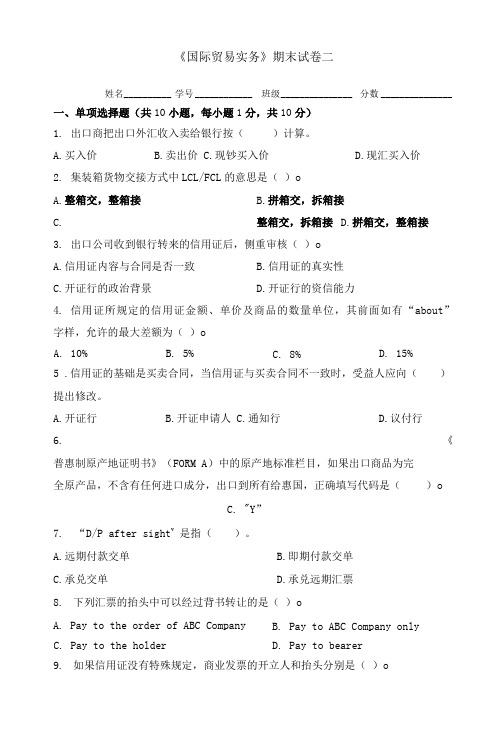
《国际贸易实务》期末试卷二姓名 __________ 学号 ____________ 班级 _______________ 分数 _______________一、单项选择题(共10小题,每小题1分,共10分)1. 出口商把出口外汇收入卖给银行按( )计算。
A.买入价B.卖出价C.现钞买入价D.现汇买入价2. 集装箱货物交接方式中LCL/FCL 的意思是( )o A.整箱交,整箱接 B.拼箱交,拆箱接C.整箱交,拆箱接 D.拼箱交,整箱接3. 出口公司收到银行转来的信用证后,侧重审核( )o A.信用证内容与合同是否一致 B.信用证的真实性 C.开证行的政治背景D.开证行的资信能力4. 信用证所规定的信用证金额、单价及商品的数量单位,其前面如有“about”字样,允许的最大差额为( )o5 .信用证的基础是买卖合同,当信用证与买卖合同不一致时,受益人应向()提出修改。
A.开证行B.开证申请人C.通知行D.议付行6.《普惠制原产地证明书》(FORM A )中的原产地标准栏目,如果出口商品为完 全原产品,不含有任何进口成分,出口到所有给惠国,正确填写代码是()oC. "Y”7. “D/P after sight v是指( )。
A.远期付款交单 C.承兑交单8. 下列汇票的抬头中可以经过背书转让的是( )o A. Pay to the order of ABC Company9. 如果信用证没有特殊规定,商业发票的开立人和抬头分别是( )oA. 10%B. 5%C. 8%D. 15%B.即期付款交单 D.承兑远期汇票B. Pay to ABC Company onlyC. Pay to the holderD. Pay to bearerA. 受益人/开证申请人B.开证行/开证申请人D.开证申请人/受益人C.受益人/开证行10.下列属于受益人审核信用证的依据是()oA.合同B.开证申请书C.结汇单据D.商业发票二、多项选择题(共10小题,每小题2分,共20分)1.下列属于以实物表示品质的是()oA.凭规格B.凭标准C.凭样品D.看货买卖2 .班轮运费里包括()oA.装卸费B.油费C.超长附加费D.港口选择费3 .根据提单是否对货物表面有批注,提单分为()oA.清洁提单B.不清洁提单C.记名提单D.指示提单4 .在CIF术语下,下列属于卖方义务的是()oA.出口报关B.保险C.运费D.进口报关5.如果有一万吨大米销往蒙古,应选择()oA. CIFB. FOBC. CIPD. CPT6.进出口商在实际业务中,选用贸易术语时应考虑下列哪些因素()oA.与运输方式相适应B.与本国文化传统相符合C.考虑办理进出口货物结关手续的难易D.考虑运价动态E.考虑承运人风险控制7.常见的出口商(受益人)证明有()oA.寄单证明B,寄样证明C.保费收据D.货物补充说明8.以下单据中,对发票起补充作用的是()。
国贸实务试题2(附参考答案)

《国际贸易实务》期末考试试卷学号:姓名:成绩:班级:课序号:任课教师:一、是非判断题(是者打√,非者打×,每题1分,共20分)得分____________ 1.国际贸易惯例可以作为解决国际贸易争端的裁决或判决依据。
(√)2.EXW术语对卖方而言,其优点是承担的义务最小,但无法控制货物运输权。
(√)3.卖方欲将货物的风险转移给买方,其前提条件是必须将货物置于买方的控制下(或将货物特定化),否则货物风险不得转移。
(√)4.依据国际公约,由买方规定样品时,贸易合同一旦出现知识产权争议,应由买卖双方负责。
(×)5.决定品质的时间和地点,当贸易合同中没有特别约定时,原则上以贸易术语来决定;若合同中有特别约定时,则依合同的特别约定为准。
(√)6.在班轮运输中,货物的装卸及配载由班轮公司负责,承托双方之间不计滞期费和速遣费,托运人与收货人不须另行支付装卸费。
(√)7.在租船运输中,承运人一般不负责货物装卸责任及其费用(FIO),因此托运人与承运人之间可能要计算滞期费和速遣费。
(√)8.根据国际运输惯例和各国法律,提单代表货物,占有提单即占有货物的控制权或所有权,并在货物运输中有权处理提单上所载明的货物。
(√)9.“空白指示、空白背书”的提单一般又称为“空白抬头、空白背书”提单,是国际贸易中使用最多的一种提单。
(√)10.海运单与提单一样,是船载货物的物权凭证,可以背书转让。
()11.由于航空运单不是物权凭证,收货人无须凭其提货,因而卖方通常无法控制收货人的付款。
(√)12.在推定全损的情况下,若被保险人想获得全损的赔偿,他必须无条件地将保险标的委付(Abandonment)给保险人。
(√)13.依据中国保险条款的规定,保险索赔时效,从被保险货物在最后卸载港全部卸离海轮后起算,最多不超过1年;依据《海牙规则》,货主(被保险人)向承运人索赔的诉讼时效为2年。
(×)14.英国ICC(A)采用“一切风险减除外责任”;ICC(B)、(C)以及战争险与罢工险则采用“列名风险”。
国际贸易实务试题和答案

国际贸易实务试题和答案一、选择题1.国际贸易的定义是什么?A. 国与国之间的商品和服务交换活动B. 跨国公司之间的贸易活动C. 同一国家之间的商品和服务交换活动D. 国内外公司之间的贸易活动答案:A. 国与国之间的商品和服务交换活动2.国际贸易的主要目的是什么?A. 实现商品和服务的自由流动B. 提高国内消费者的福利水平C. 满足国内企业的需求D. 增加国内就业机会答案:B. 提高国内消费者的福利水平3.国际贸易的主要形式有哪些?A. 出口贸易和进口贸易B. 跨国贸易和地区贸易C. 两个国家之间的贸易和多个国家之间的贸易D. 实物贸易和服务贸易答案:A. 出口贸易和进口贸易二、填空题1.什么是关税?关税是政府对进口和出口商品征收的税费。
2.什么是贸易壁垒?贸易壁垒是指政府为了保护本国产业或限制进口而采取的各种措施,如关税、配额、进口限制等。
三、简答题1.解释贸易逆差和贸易顺差的概念,并分析其对国家经济的影响。
贸易逆差是指一个国家的出口额小于进口额,贸易顺差则相反。
贸易逆差可能导致国家外汇储备减少,经济增长受阻,失业率上升;而贸易顺差可能导致外汇储备增加,经济增长加快,就业机会增加。
2.解释自由贸易区和关税同盟的区别。
自由贸易区是指成员国之间取消了彼此之间的关税壁垒,但仍然保留自己与非成员国之间的关税政策。
而关税同盟则是指成员国之间不仅取消了彼此之间的关税壁垒,还实行了统一的对非成员国的关税政策。
3.请列举一些国际贸易的组织和协议,并简要介绍其主要目标和作用。
一些国际贸易的组织和协议包括世界贸易组织(WTO)、欧盟、北美自由贸易协定(NAFTA)等。
世界贸易组织的主要目标是促进全球贸易自由化,管理和监督国际贸易规则的实施。
欧盟的主要目标是建立欧洲内部的自由贸易区,并推动欧洲经济一体化。
北美自由贸易协定旨在促进北美地区的贸易自由化,促进经济发展。
四、论述题请你发表你对于贸易保护主义和自由贸易主义的观点,并给出你的理由。
国际贸易实务考试试题
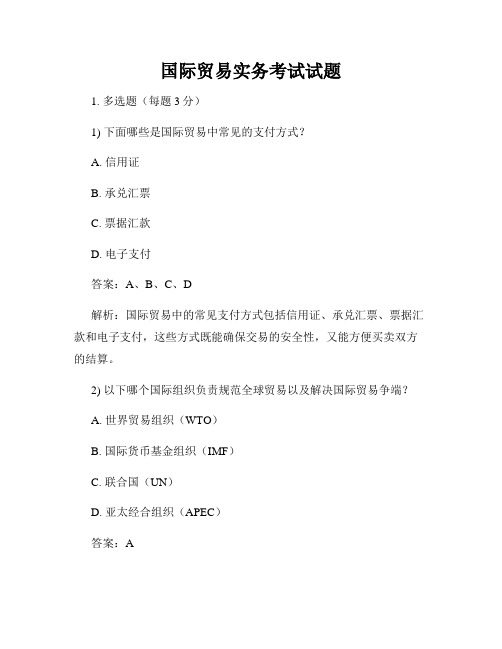
国际贸易实务考试试题1. 多选题(每题3分)1) 下面哪些是国际贸易中常见的支付方式?A. 信用证B. 承兑汇票C. 票据汇款D. 电子支付答案:A、B、C、D解析:国际贸易中的常见支付方式包括信用证、承兑汇票、票据汇款和电子支付,这些方式既能确保交易的安全性,又能方便买卖双方的结算。
2) 以下哪个国际组织负责规范全球贸易以及解决国际贸易争端?A. 世界贸易组织(WTO)B. 国际货币基金组织(IMF)C. 联合国(UN)D. 亚太经合组织(APEC)答案:A解析:世界贸易组织(WTO)是一个全球性的组织,负责规范全球贸易,并协调解决发生在各国之间的国际贸易争端。
3) 在国际贸易中,下列哪些因素会影响汇率?A. 经济因素B. 政治因素C. 利率差异D. 货币供应量答案:A、B、C、D解析:汇率是由多种因素综合影响所形成的,包括经济因素、政治因素、利率差异和货币供应量等。
这些因素的变化会导致汇率的波动。
2. 简答题(每题10分)1) 解释何为贸易保护主义,并列举出两个常见的贸易保护主义措施。
贸易保护主义是指国家采取的旨在保护本国经济利益的贸易政策。
常见的贸易保护主义措施包括:- 征收关税:通过对进口商品征收高额关税,提高进口商品价格,从而减少进口量,保护本国产业。
- 实施配额限制:设置进口商品的配额限制,限制进口量,以保护本国产业免受外国竞争的冲击。
2) 请解释国际贸易中的术语“最惠国待遇”和“国民待遇”。
- 最惠国待遇:指在国际贸易中,一个国家对其他所有世界贸易组织成员国给予的最优惠的贸易条件和待遇。
即一个国家给予某一成员国的贸易待遇,也必须同样给予其他所有成员国。
- 国民待遇:指在国际贸易中,一个国家对本国企业和外国企业给予同等的待遇。
即一个国家不能对外国企业设置歧视性措施,而只给予本国企业特殊的优惠待遇。
3. 论述题(30分)请以“跨境电商对国际贸易的影响”为题,就跨境电商对国际贸易的影响进行论述。
国贸实务试题2(附参考答案)
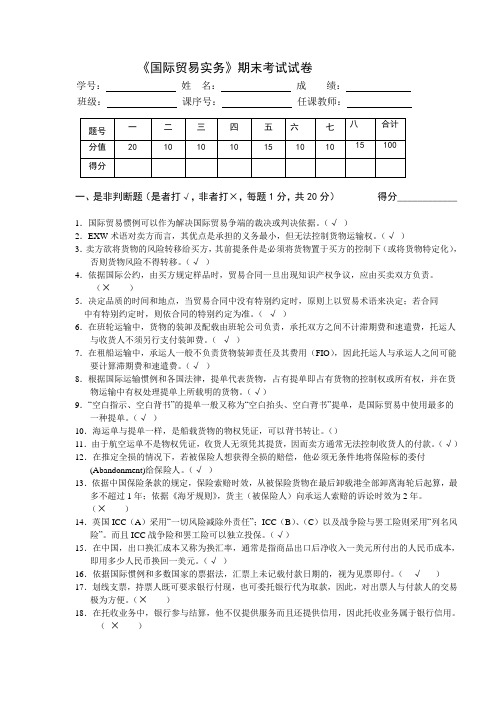
《国际贸易实务》期末考试试卷学号:姓名:成绩:班级:课序号:任课教师:一、是非判断题(是者打√,非者打×,每题1分,共20分)得分____________ 1.国际贸易惯例可以作为解决国际贸易争端的裁决或判决依据。
(√)2.EXW术语对卖方而言,其优点是承担的义务最小,但无法控制货物运输权。
(√)3.卖方欲将货物的风险转移给买方,其前提条件是必须将货物置于买方的控制下(或将货物特定化),否则货物风险不得转移。
(√)4.依据国际公约,由买方规定样品时,贸易合同一旦出现知识产权争议,应由买卖双方负责。
(×)5.决定品质的时间和地点,当贸易合同中没有特别约定时,原则上以贸易术语来决定;若合同中有特别约定时,则依合同的特别约定为准。
(√)6.在班轮运输中,货物的装卸及配载由班轮公司负责,承托双方之间不计滞期费和速遣费,托运人与收货人不须另行支付装卸费。
(√)7.在租船运输中,承运人一般不负责货物装卸责任及其费用(FIO),因此托运人与承运人之间可能要计算滞期费和速遣费。
(√)8.根据国际运输惯例和各国法律,提单代表货物,占有提单即占有货物的控制权或所有权,并在货物运输中有权处理提单上所载明的货物。
(√)9.“空白指示、空白背书”的提单一般又称为“空白抬头、空白背书”提单,是国际贸易中使用最多的一种提单。
(√)10.海运单与提单一样,是船载货物的物权凭证,可以背书转让。
()11.由于航空运单不是物权凭证,收货人无须凭其提货,因而卖方通常无法控制收货人的付款。
(√)12.在推定全损的情况下,若被保险人想获得全损的赔偿,他必须无条件地将保险标的委付(Abandonment)给保险人。
(√)13.依据中国保险条款的规定,保险索赔时效,从被保险货物在最后卸载港全部卸离海轮后起算,最多不超过1年;依据《海牙规则》,货主(被保险人)向承运人索赔的诉讼时效为2年。
(×)14.英国ICC(A)采用“一切风险减除外责任”;ICC(B)、(C)以及战争险与罢工险则采用“列名风险”。
大学专业课程《国际贸易实务》试题及答案(二)
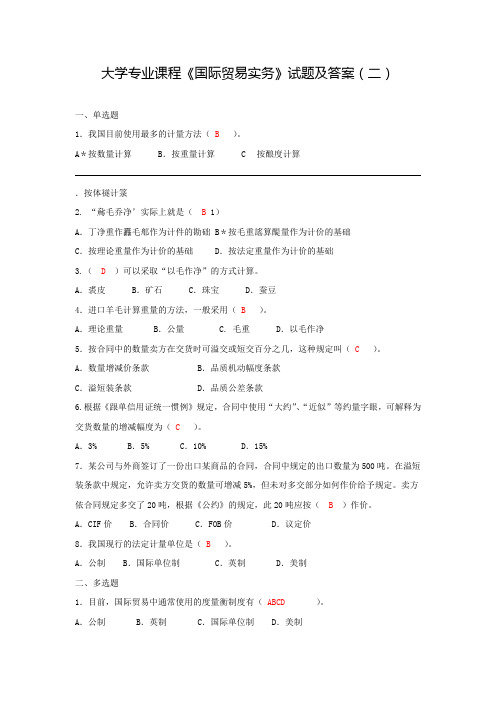
大学专业课程《国际贸易实务》试题及答案(二)一、单选题1.我国目前使用最多的计量方法( B )。
A*按数量计算B.按重量计算 C按酿度计算.按体禭计箓2. “䲥毛乔净’实际上就是(B 1)A.丁净重作䨺毛郍作为计件的勘础 B*按毛重謠算醍量作为计价的基础C.按理论重量作为计价的基础 D.按法定重量作为计价的基础3.( D )可以采取“以毛作净”的方式计算。
A.裘皮 B.矿石C.珠宝D.蚕豆4.进口羊毛计算重量的方法,一般采用( B )。
A.理论重量 B.公量 C. 毛重 D.以毛作净5.按合同中的数量卖方在交货时可溢交或短交百分之几,这种规定叫( C )。
A.数量增减价条款 B.品质机动幅度条款C.溢短装条款 D.品质公差条款6.根据《跟单信用证统一惯例》规定,合同中使用“大约”、“近似”等约量字眼,可解释为交货数量的增减幅度为(C )。
A.3% B.5% C.10% D.15%7.某公司与外商签订了一份出口某商品的合同,合同中规定的出口数量为500吨。
在溢短装条款中规定,允许卖方交货的数量可增减5%,但未对多交部分如何作价给予规定。
卖方依合同规定多交了20吨,根据《公约》的规定,此20吨应按( B )作价。
A.CIF价 B.合同价 C.FOB价 D.议定价8.我国现行的法定计量单位是( B )。
A.公制 B.国际单位制 C.英制 D.美制二、多选题1.目前,国际贸易中通常使用的度量衡制度有(ABCD )。
A.公制 B.英制 C.国际单位制 D.美制2.国际贸易计算重量时,通常的计算方法有( ABCD)。
A.毛重 B.净重 C.公量 D.理论重量3.在采用净重计重时,国际上通常计算包装重量的做法有( ABCD )。
A.按实际皮重计算 B.按平均皮重计算C.按习惯皮重计算 D.按约定皮重计算4.溢短装条款的内容包括有( ABC )。
A.溢短装的百分比 B.溢短装的选择权C.溢短装部分的作价 D.买方必须收取溢短装的货物5.溢短装数量的计价方法包括( ABC )。
国际贸易试题库

《国际贸易实务》试题库一一、单项选择题(本大题共10小题,每小题1分,共10分)1.如2007年,某国出口贸易额为380亿美元,进口额为360亿美元,则该国( B ) A.净出口额为20亿美元 B.贸易顺差为20亿美元C.净进口额为20亿美元 D.贸易逆差为20亿美元2、对于大批量交易的散装货,因较难掌握商品的数量,通常在合同中规定( B )A.品质公差条款 B.溢短装条款 C.立即装运条款 D.仓至仓条款3.L/C与托收相结合的支付方式,其全套货运单据应(B )A.随信用证项下的汇票 B.随托收项下的汇票C.50%随信用证项下的汇票,50%随托收项下的汇票D.单据与票据分列在信用证和托收汇票项下4、信用证的第一付款人是( B )A.进口人 B.开证行 C.议付行 D.通知行5、一张经过了五次背书的汇票,其“前手”最多有(D )个。
A.3 B.4 C.5 D.66、出口总成本是指( C )A.进货成本 B.进货成本+出口前一切费用C.进货成本+出口前的一切费用+出口前的一切税金 D.对外销售价7、承兑是( A )对远期汇票表示承担到期付款责任的行为。
A.付款人 B.收款人 C.出口人 D.开证银行8、根据《联合国国际货物销售合同公约》的规定,发盘和接受的生效采取( D )A.投邮生效原则 B.签订书面合约原则 C.口头协商原则 D.到达生效原则9、审核信用证的依据是( C )A.开证申请书 B.—整套单据 C.合同 D.商业发票10、以下我出口商品的单价,只有( B )的表达是正确的。
A.250美元/桶 B.250美元/桶CIF伦敦C.250美元/桶CIF广州 D.250美元二、多项选择题(本大题共10小题,每小题2分,共20分)1.对于信用证与合同关系的表述正确的是(A B CD )A.信用证的开立以买卖合同为依据B.信用证的履行不受买卖合同的约束C.有关银行只根据信用证的规定办理信用证业务D.合同是审核信用证的依据2、在国际贸易中,最常用的支付方式有( BCD )A.预付 B.汇付 C.托收 D.信用证3、FOB、CFR、CIF 和 FCA、CPT、CIP术语的主要区别是( AB C D )A.适用的运输方式不同B.风险转移的地点不同C.装卸费用的负担不同D.运输单据不同4、在国际贸易中,解决争议的方法主要有(C ABD )A.友好协商 B.调解 C.仲裁 D.诉讼5、交易磋商程序中,必不可少的两个法律环节是( BD )A.询盘 B.发盘 C.还盘 D.接受6、若买卖双方以CFR卸至岸上术语成交,以下答案正确的是(D C )A.卖方应承担货物运至目的港以前的一切风险B.当货物卸至目的港后,卖方的交货完毕C.装运港的船舷是买卖双方风险划分的界限D.卖方在装运港船上完成交货义务7、一方同意以每公吨300美元的价格向买方出售1200公吨一级大米,合同和信用证金额都为36万美元。
国际贸易实务试题库1——5

国际贸易实务试题库1——5《国际贸易实务》试题库一一、单项选择题(本大题共10小题,每小题1分,共10分)1.如2007年,某国出口贸易额为380亿美元,进口额为360亿美元,则该国( ) A.净出口额为20亿美元B.贸易顺差为20亿美元C.净进口额为20亿美元D.贸易逆差为20亿美元2、对于大批量交易的散装货,因较难掌握商品的数量,通常在合同中规定( )A.品质公差条款B.溢短装条款C.立即装运条款D.仓至仓条款3.L/C与托收相结合的支付方式,其全套货运单据应()A.随信用证项下的汇票B.随托收项下的汇票C.50%随信用证项下的汇票,50%随托收项下的汇票D.单据与票据分列在信用证和托收汇票项下4、信用证的第一付款人是( )A.进口人B.开证行C.议付行D.通知行5、一张经过了五次背书的汇票,其“前手”最多有()个。
A.3 B.4 C.5 D.66、出口总成本是指( )A.进货成本B.进货成本+出口前一切费用C.进货成本+出口前的一切费用+出口前的一切税金D.对外销售价7、承兑是( )对远期汇票表示承担到期付款责任的行为。
A.付款人B.收款人C.出口人D.开证银行8、根据《联合国国际货物销售合同公约》的规定,发盘和接受的生效采取( ) A.投邮生效原则B.签订书面合约原则C.口头协商原则D.到达生效原则9、审核信用证的依据是( )A.开证申请书B.—整套单据C.合同D.商业发票10、以下我出口商品的单价,只有( )的表达是正确的。
A.250美元/桶B.250美元/桶CIF伦敦C.250美元/桶CIF广州D.250美元二、多项选择题(本大题共10小题,每小题2分,共20分)1.对于信用证与合同关系的表述正确的是()A.信用证的开立以买卖合同为依据B.信用证的履行不受买卖合同的约束C.有关银行只根据信用证的规定办理信用证业务D.合同是审核信用证的依据2、在国际贸易中,最常用的支付方式有( )A.预付B.汇付C.托收D.信用证3、FOB、CFR、CIF 和FCA、CPT、CIP术语的主要区别是()A.适用的运输方式不同B.风险转移的地点不同C.装卸费用的负担不同D.运输单据不同4、在国际贸易中,解决争议的方法主要有( )A.友好协商B.调解C.仲裁D.诉讼5、交易磋商程序中,必不可少的两个法律环节是( )A.询盘B.发盘C.还盘D.接受6、若买卖双方以CFR卸至岸上术语成交,以下答案正确的是()A.卖方应承担货物运至目的港以前的一切风险B.当货物卸至目的港后,卖方的交货完毕C.装运港的船舷是买卖双方风险划分的界限D.卖方在装运港船上完成交货义务7、一方同意以每公吨300美元的价格向买方出售1200公吨一级大米,合同和信用证金额都为36万美元。
国际贸易实务考题2参考答案
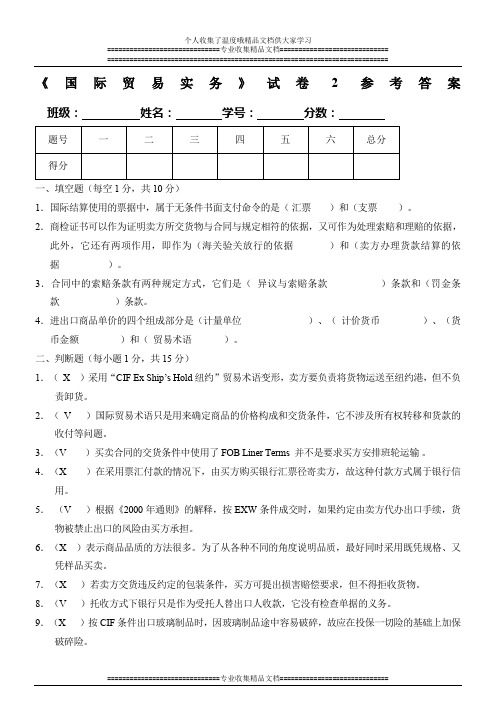
《国际贸易实务》试卷2参考答案班级:姓名:学号:分数:一、填空题(每空1分,共10分)1.国际结算使用的票据中,属于无条件书面支付命令的是(汇票)和(支票)。
2.商检证书可以作为证明卖方所交货物与合同与规定相符的依据,又可作为处理索赔和理赔的依据,此外,它还有两项作用,即作为(海关验关放行的依据)和(卖方办理货款结算的依据)。
3.合同中的索赔条款有两种规定方式,它们是(异议与索赔条款)条款和(罚金条款)条款。
4.进出口商品单价的四个组成部分是(计量单位)、(计价货币)、(货币金额)和(贸易术语)。
二、判断题(每小题1分,共15分)1.(X )采用“CIF Ex Ship’s Hold纽约”贸易术语变形,卖方要负责将货物运送至纽约港,但不负责卸货。
2.(V )国际贸易术语只是用来确定商品的价格构成和交货条件,它不涉及所有权转移和货款的收付等问题。
3.(V )买卖合同的交货条件中使用了FOB Liner Terms 并不是要求买方安排班轮运输。
4.(X )在采用票汇付款的情况下,由买方购买银行汇票径寄卖方,故这种付款方式属于银行信用。
5.(V )根据《2000年通则》的解释,按EXW条件成交时,如果约定由卖方代办出口手续,货物被禁止出口的风险由买方承担。
6.(X )表示商品品质的方法很多。
为了从各种不同的角度说明品质,最好同时采用既凭规格、又凭样品买卖。
7.(X )若卖方交货违反约定的包装条件,买方可提出损害赔偿要求,但不得拒收货物。
8.(V )托收方式下银行只是作为受托人替出口人收款,它没有检查单据的义务。
9.(X )按CIF条件出口玻璃制品时,因玻璃制品途中容易破碎,故应在投保一切险的基础上加保破碎险。
10.(X )采用信用证付款时,通常都要求受益人开具汇票,而不能仅凭受益人提供的单据付款。
11.(X )所谓“空白抬头,空白背书”的提单,是指既不用填写受货人,又不需要背书的提单。
12.(X )由于仲裁裁决是终局性的裁决,因此,凡仲裁机构做出的一切裁决,不论在任何情况下,法院都须一律执行。
- 1、下载文档前请自行甄别文档内容的完整性,平台不提供额外的编辑、内容补充、找答案等附加服务。
- 2、"仅部分预览"的文档,不可在线预览部分如存在完整性等问题,可反馈申请退款(可完整预览的文档不适用该条件!)。
- 3、如文档侵犯您的权益,请联系客服反馈,我们会尽快为您处理(人工客服工作时间:9:00-18:30)。
《国际贸易实务》试题2说明:所有题目的答案,全部写在答题纸上一、名词解释(每小题4分,共20分)要求:先翻译成中文,然后用中文解释1、Shipping Mark2、W/W Clause3、D/A4、Packing List5、Consignment二、判断题(每小题2分,共10分)1、The exporter is required, under CIF, to take out marine insurance, which covers the total value of the contract plus indefinite percentage of expected profit.2、The quality clause is a supplementary clause of sales contract.3、The commodities inspection is an important step that should not be ignored by traders, because the illegal inspection of commodities can make sure good quality and protect the benefit and right of consumers.4、Penalty clause is fixed when the seller fails to make timely delivery; The buyer fails to issue the relevant L/C, or the buyer fails to take delivery on time, and the penalty ceiling is also included in the contract.5、Force majeure actually means that the frustration of the contract by the party in question results from natural or social forces that include flood, earthquake, typhoon, fire, war and government decrees of prohibition out of the control of mankind.三、简答题(每小题10分,共30分)1、国际货物买卖合同中,装运条款通常包括哪些主要内容?2、简述海运提单的性质与作用。
3、简述出口业务中销售代理和经销之间的根本区别?四、计算题(每小题10分,共10分)上海运往肯尼亚蒙巴萨港口的“门锁”一批,计100箱,每箱体积为20厘米×30厘米×40厘米,毛重(G.W.)为25公斤。
当时,燃油附加费为30%,蒙巴萨港口拥挤附加费为10%。
“门锁”属于小五金类,计收标准是W/M,等级为10级;基本运费为:每运费吨443.00港元。
试计算应付运费是多少?五、英译汉(3小题,共10分)1、Under the more or less clause, the payment for the over-delivered or under-delivered will be effected according to the contract price or at the market price at the time of shipment.2、If the exported goods are damaged or lost during transit, the consignee or his agentshould lodge a claim against the Survey and Claim Settlement Agent of the insurer at the place of destination.3、Since applicable laws concerning arbitration differ from country to country, and different applicable laws differ in their interpretations in respect of the rights and obligations of the parties concerned, therefore, parties concerned are always making efforts to choose an arbitration place they trust and know quite well.六、案例题(每小题10分,共20分)1、我某公司与外商按CIF条件、签订了一笔大宗商品出口合同。
合同规定的装运期是8月份,但未规定具体开证日期。
外商推延开证,我方见装运期快到,从7月底开始,连续多次电催促外商开证。
8月5日,我方收到开证行的简电通知。
我方因为害怕耽误装运期,即按简电办理装运。
8月28日,我方才收到信用证证实书,该证实书在单据要求方面做出了与合同不符的规定;而我方经办人在审证时未予注意。
直到我方交银行议付时,我方银行也未发现。
开证行即以单证不符为由,拒绝付款。
你认为,我方应从中吸取哪些教训?2、根据信用证内容,回答问题。
FROM: INDUSTRIAL BANK OF JAPAN,LIMITED,TOKYOTO: BANK OF CHINA, SHANGHAISQUENCE OF TOTAL: 1/1FORM OF DOC. CREDIT: IRREVOCABLEDOCU. CREDIT NO.: ILC136107800DATE OF ISSUE: 991015DATE N PLACE OF EXP.: 991215 IN THE COUNTRY OF BENEFICIARYAPPLICANT: ABC COMPANY, 1-3 MACHI KU STREET,OSAKA,JAPANBENEFICIARY: SHANGHAI DA SHENG CO.,LTD. UNIT C,2/F,JINGMAO TOWER, SHANGHAI, CHINA. CURRENCY CODE, AMOUNT: USD21240.00AVAILABLE WITH /.BY: ANY BANK BY NEGOTIATIONDRAFTS: SIGHT FOR 100PCT INVOICE VALUEDRAWEE: THE INDUSTRIAL BANK OF JAPAN, HEAD OFFICEPARTIAL SHIPMENT: ALLOWEDTRANSSHIPMENT: NOT ALLOWEDLOAD/DISPATCH/TAKING: CHINESE PORTSTRANSPORTATION TO: OSAKA/TOKYOLATEST DATE OF SHIPMET: 991130DESCRIP GOODS/SERVICE: 4,000 PCS "DIAMOND" BRAND CLOCKART NO. 791 AT USD5.31 PER PIECE CIF OSAKA/TOKYO PACKED IN NEW CARTONSSHIPPING MARK: ABC/OSAKA/NO.: 1-UPDOCUMENTS REQUIRED:1. SIGNED COMMERCIAL INVOICE IN QUADRUPLICATE2. SIGNED PACKING LIST IN TRIPLICATE3. CERTIFICATE OF CHINESE ORIGIN IN DUPLICATES STATING THE IMPORTING COUNTARY AS JAPAN DULY SIGNED BY CHAMBER OF COMMERCE4. INSURANCE POLICIES OR CERTIFICATE ENDORSED IN BLANK FOR 110 PCT OF CIF VALUE, COVERING W.P.A RISK AND WAR RISK5. FULL SET OF CLEAN ‘ON BOARD’ OCEAN BILLS OF LADING, MADE OUT TO ORDER AND BLANK ENDORSED MARKED ‘FREIGHT PREPAID' AND NOTIFY APPLICANTADDITIONAL CONDITIONS:ALL DRAFTS DRAWN HEREUNDER MUST BE MARKED “DRAWN UNDER INDUSTRIAL BANK OF JAPAN, LTD., HEADOFFICE, CREDIT NO. ILC136107800 DATED OCT.15,1999” AND THE AMOUNT OF SUCH DRAFTS MUST BE ENDORSED ON THE REVERSE OF THIS CREDIT. T/T REIMBURSEMENT IS NOT ACCEPTABLE DETAILS OF CHARGES: ALL BANKING CHARGES OUTSIDE JANPAN ARE FOR BENEFICIARY'S ACCOUNT PRESENTAION PERIOD: DOCUMENTS MUST BE PRESENTED WITHIN 10 DAYS AFTER THE DATE OF ISSUANCE OF THE SHIPPING DOCUMENTS BUT WITHIN THE VALIDITY OF THE CREDITCONFIRMATION: WITHOUTSPECIAL INSTRUCTION TO THE ADVISING BANK: ALL DOCUMENTS INCLUDING BENEFICIARY'S DRAFTS MUST BE SENT BY COURIER SERVICE DIRECTLY TO OUR HEAD OFFICE. MARUNOUCHI, CHIYODA-U, TOKYO, JAPAN 100,ATTN. INTER-NATIOANL BUSINESS DEPT. IMPORT SECTION, IN ONE LOT. UPON OUR RECEIPT OF THE DRAFTS AND DOCUMENTS, WE SHALL MAKE PAYMENT AS INSTRUCTED BY YOU.请回答下列问题:(1)L/C的开证申请人、开证银行、通知银行、受益人。
